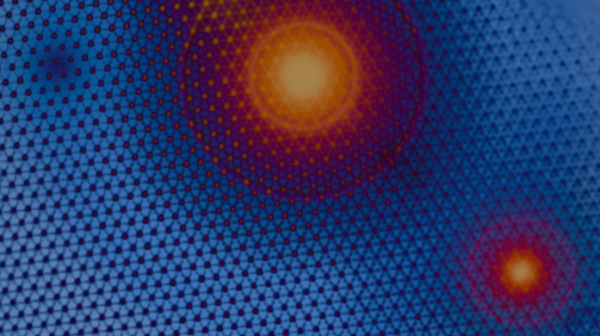A New Era for Electron Microscopy in Cardiff
21 December 2021
A microscope with the ability to image the smallest of objects will arrive at Cardiff Catalysis Institute (CCI) later this month. Cardiff’s first Aberration Corrected Scanning Transmission Electron Microscope (AC-STEM) will allow researchers across the University’s new translational Research Hub (TRH) to build on their world-renowned reputation for novel catalyst development. Thomas E. Davies, from the School of Chemistry, explains more.
 “Over the past year the CCI’s Electron Microscopy (EM) team have been working closely with Thermo Fisher ScientificTM to ready the CCI Electron Microscopy Facility (CCI-EMF) for the installation of Wales’ first Cold Field Emission Gun Spectra 200 S/TEM.
“Over the past year the CCI’s Electron Microscopy (EM) team have been working closely with Thermo Fisher ScientificTM to ready the CCI Electron Microscopy Facility (CCI-EMF) for the installation of Wales’ first Cold Field Emission Gun Spectra 200 S/TEM.
The platform has been specifically configured to enhance the catalyst characterisation capability of the CCI, enabling atomic resolution imaging and chemical analysis of heterogeneous catalysts.
The ability to image the smallest of objects, such as the atom, is limited by the effect of aberrations in a microscope’s lens system but with the Spectra’s integrated S-CORR aberration corrector, sub-Angstrom STEM imaging will be routine.
In fact, the ability to image single site catalysts (SSCs) like those composed of isolated atoms of gold is only possible with this technology (Nature Chemistry vol. 12, 560–567, 2020).
The resolving power and increased sensitivity to lighter elements is further enhanced by the ultra-low-noise segmented Panther STEM detection system which will enable low-dose imaging of beam-sensitive materials such as zeolites, an important class of porous catalytic material used both industrially and in the research laboratory.
 Advanced analytics such as the Super-X Energy Dispersive X-Ray (EDX) spectrometer and Gatan’s Continuum detector for Energy Electron Loss Spectroscopy (EELS) will allow for the rapid and accurate acquisition of compositional information and trace element detection.
Advanced analytics such as the Super-X Energy Dispersive X-Ray (EDX) spectrometer and Gatan’s Continuum detector for Energy Electron Loss Spectroscopy (EELS) will allow for the rapid and accurate acquisition of compositional information and trace element detection.
The Continuum EELS system will be the first of its type in Wales and represents the next generation of EELS and energy filtered electron microscopy, including in-situ functionality to allow direct real-time observation of oxidation/reduction processes in the microscope.
Chemical mapping will facilitate the precise atom by atom design and synthesis of complex catalytic materials like those used for pollution abatement and the clean-up of greenhouse gases (ACS Catal. 2020, 10, 5430-5442). Coupled with Quantum Detectors’ Merlin Medipix Direct Electron Detector (DED), the Spectra 200 will also be capable of 4D STEM and dynamical TEM imaging.
With investment from the European Regional Development Fund through the Welsh European Funding Office (WEFO), HEFCW and The Wolfson Foundation, the new EM facility will not only house the new Spectra 200 but also re-house the existing CCI electron microscopes all under one roof in a purpose-built microscopy facility designed to be “ultra-quiet”, electromagnetically shielded and vibration free.
The space will be shared with Cardiff’s outstanding surface science facility with the laboratories located right across the corridor from the new AC-STEM.
These will house the UK’s first Photo-induced Force Microscope (PiFM) for nanoscale topography and vibrational spectroscopy alongside a new Tip Enhanced Raman Spectroscopy (TERS) technique and Cardiff’s already renowned X-ray Photoelectron Spectroscopy (XPS) capability.
The co-location of these state-of the art instruments, techniques and expertise will provide a unique centre for materials imaging and spectroscopic analysis.
The construction of this scientifically advanced building has been undertaken by Bouygues UK as part of Cardiff University’s new Innovation Campus, which also includes the Translational Research Hub (TRH) and sbarc|spark buildings.
 The TRH’s aim is to foster partnerships with national and international enterprises, promote academic-to-business relationships and fuel economic growth in Wales, and the new EM facility is perfectly situated to advance the suite of catalyst testing and characterization laboratories that are already part of the CCI.
The TRH’s aim is to foster partnerships with national and international enterprises, promote academic-to-business relationships and fuel economic growth in Wales, and the new EM facility is perfectly situated to advance the suite of catalyst testing and characterization laboratories that are already part of the CCI.
The CCI-EMF aims to become the core centre of expertise in microscopy in catalysis as well as providing a centralised suite of microscopy for characterising other nanomaterials and advanced materials (e.g., semiconductor devices, optoelectronic and photonic materials, and novel 2D materials).
It will act as a hub for surrounding industry and R&D activities requiring electron microscopy analysis not only for catalysis development but also materials characterisation, failure analysis, reverse engineering, and quality control studies that require visualisation and compositional analysis capabilities down to the atomic scale.
Thomas E. Davies
Cardiff University, School of Chemistry
https://www.cardiff.ac.uk/cardiff-catalysis-institute-electron-microscope-facility
The author would like to thank the European Regional Development Fund (ERDF), the Welsh European Funding Office (WEFO), The Wolfson Foundation, The Higher Education Funding Council for Wales (HEFCW), Thermo Fisher Scientific and Cardiff University for their support.


